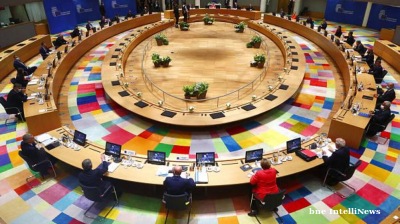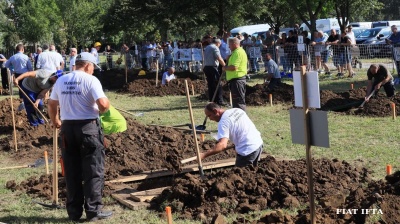Ukrainian social media has been set ablaze in recent weeks by calls for Nato to impose a no-fly zone over Ukrainian skies. Ukrainians are sharing images of Russian air strikes on Ukrainian civilian areas and using the #Closethesky hashtag and tagging Nato directly. Surveys by Ukraine’s Rating Group show that a staggering 90% of Ukrainians, including President Volodymyr Zelenskiy himself, support the imposition of a no-fly zone.
Tanya, 32, from Chernivtsi, echoes these thoughts. She cannot understand why Nato doesn't close the skies over Ukraine. She believes that on land Ukraine can manage itself, but in the air “we have no protection against bombs and rockets. What can be worse? What is Nato afraid of?”
This frustration is similarly felt by Kyiv resident Valeriia, 24. "If Nato can close the sky to prevent attacks on hospitals from happening, they should do it", she said, citing the attack on the Mariupol maternity hospital last week. In a biting criticism of the Alliance's lack of military support, she stated that "it is convenient for Nato that Ukraine fights back on its own."
According to Ilya, 26, originally from Donetsk and currently volunteering with his country’s war effort, a no-fly zone cannot come quick enough “Ukrainians are forced to flee from rockets and bombs from the skies above.” However, unlike the 50% of Ukrainians who think that Nato will at some point impose a no-fly zone over Ukraine, Ilya believes the opposite. In his words, “the world is watching from afar, cynically using Ukraine as a human shield against Russia.”
“Closing the sky” might be popular for Ukrainians, but what would a no-fly zone look like? Mikey Kay, a former assault helicopter operator, and joint strategic planner with over 20 years' experience operating in theatres such as Kosovo, Iraq and Afghanistan, states that “there is no such thing as an offensive no-fly zone, they are by nature defensive.” No-fly zones are "particular to defensive counter-air operations," in other words shooting down enemy aircraft when they enter a certain defined airspace, as opposed to offensive counter-air operations which would involve destroying enemy air assets when they are on the ground.
Kay is still opposed to any use of Nato planes, or "combat air patrols," to establish a no-fly zone in Ukraine, believing that a no-fly zone in all but name can be established by providing Ukrainian forces with significant anti-aircraft weaponry rather than by the insertion of Nato jets into Ukrainian airspace. The use of any Nato warplanes over the skies in Ukraine presents a number of enormously difficult decisions for Nato pilots to make, such as whether they should shoot down Russian Ilyushin-76 transport planes using Ukrainian airspace to transport troops to the battlefield, such as paratroopers. Kay points to the Soviet experience in Afghanistan, where Mujahideen forces deftly used stinger missiles (FIM-92) to wreak havoc on Soviet airpower and reduce its potency in the conflict as a potential example for Ukraine following its invasion by Russia.
Despite emphasising the need for Kyiv to be able to arm itself, in particular to combat Russia’s current air superiority, Kay stresses it is also key for Putin to have a way out of the conflict in order to prevent a catastrophic escalation if fortunes in Ukraine turn against him. Kay believes that there is currently no room for a diplomatic compromise as Russian forces are not depleted enough to force Putin to the negotiating table. However, Kay has mentioned the way that Biden effectively ruled out Nato for Ukraine is a message to Putin that was carefully worded to reduce the idea that Nato is a threat and is a first step towards something resembling a compromise.
Former brigadier in the British Army Alan Richmond is also against the use of Nato planes to enforce a no-fly zone in Ukrainian air space, believing, as many do, that this would create a World War Three scenario. He also believes that the supply of anti-aircraft missile systems like MANPADS will allow Ukraine to contest airspace and prevent Russian air supremacy. However, he does concede that MANPADs are a bit short-range and it is possible that longer-range anti-aircraft systems that can deny whole areas, such as the Russian S400, British Rapier, French Roland or new the Sky Sabre system, could be used.
Richmond pointed out that Ukraine is having some success with their own aircraft and especially the Turkish supplied Bayraktar drones in terms of destroying Russian armour and command and control. He states that denying airspace to Russia through the use of a no-fly zone would also deny Ukraine use of its own air space to attack Russian formations and high-value targets such as long-range missile systems and artillery already stationed on Ukrainian territory. In addition, a no-fly zone does not stop the artillery and rocket attacks that are currently wreaking havoc on Ukrainian civilian areas, although some area air defence could help with some protection, citing the case of Israel’s success at defending against Iraqi SCUDS in the First Gulf War. Russia’s recent attack on the Yaroviv training centre in Lviv was actually launched from bombers operating inside Russian airspace.
As well as arming Ukraine with air defence weaponry, Richmond also supports the supply of additional aircraft, although the manner in which it is delivered is key. Richmond does not support the use of Nato bases, such as those like Ramstein in Germany, being used for Ukrainian pilots to collect aircraft and fly them to Ukraine. This is another potential World War Three scenario, and given Russia’s quite sophisticated air defence system including airborne radar, they could begin shooting at these planes whilst they are transiting Nato territory. He believes that there are plenty of more imaginative ways to get aircraft over Ukraine’s borders, describing how MiG 29s, the aircraft Poland suggested supplying Ukraine, have folding wings. Under cover of darkness, these warplanes could be sent to Ukraine inconspicuously.
Richmond is positive about the successes Ukraine has had in defending its country so far, and how much the UK and other Nato partners have already done to build up Ukrainian armed forces, believing them to be a very different army from 2014. He was personally involved in advising the transformation of Ukrainian command and control military ops, and other UK training missions such as the BMATT in Vyskov, Czech Republic, by training junior leaders, instructing battlefield first aid and defensive operations. Operation Orbital alone has trained around 20,000 combat troops in low-level tactics and techniques.
Meanwhile, Russia’s army has not improved as much as Putin’s generals may have been telling him. After what was ultimately a Pyrrhic victory in Georgia in 2008 Russia embarked on a military modernisation campaign, although Richmond has stated that to the trained military eye, there are still key mistakes being made by Russian armed forces in Ukraine that one would not expect of a serious military force in the 21st century. Richmond cites poor co-ordination between land and air forces (perhaps a factor in why Russian air power has not featured much in the conflict so far), poor combined arms integration (such as tanks lacking infantry support) and woeful logistics as major military blunders plaguing the invading force.
In terms of a diplomatic compromise, Richmond believes it is key for Putin to be able to save face but it must also be ensured he can’t be rewarded for his Ukrainian invasion. He cites positive development in negotiations, which are increasingly pragmatic. Putin’s hand is not yet that strong in Ukraine, having only seized one regional capital (Kherson) so far, and he may also be coming to this conclusion.
However, he has got his land bridge, often cited as a key goal of Putin since 2014, connecting Crimea to the Donetsk and Luhansk regions, with a railway route established since the capture of Volnovakha on March 12. If, as some analysts suggest, the real battle in Ukraine is not centred around seizing Kyiv and decapitating the government quickly, but rather firstly destroying the bulk of Ukraine’s forces which are stationed in Donbas, and then regrouping to seize more territory, Putin’s hand could strengthen as the conflict goes on if he achieves this goal.
Possible compromises could be neutral status for Ukraine, special status for Donbas regions within Ukraine and also Crimea, with the Russian Black Sea Fleet still stationed there. Putin, failing to seize many major cities like Kharkiv and Chernigiv, may pursue more limited aims, one bite at a time, as there is only so much isolating and destroying of cities that can be done before even domestic public opinion begins to turn against him. Ultimately it is China, which has stayed resolutely neutral in this conflict, who may prove to be pivotal to its resolution.
Features
_1758174730.jpg)
Indonesia’s Raja Ampat - tourism hub or den of corruption?
In recent years, Indonesia has doubled down on promoting Raja Ampat, a remote archipelago in West Papua famed for its biodiversity, as a global eco-tourism icon.

Flood corruption scandal shakes the Philippines
The Philippines is grappling with a widespread controversy surrounding its flood control programme, with allegations of billions of pesos being siphoned off from projects meant to protect vulnerable communities.

The European Commission proposes to “creatively” tap Russia’s $300bn of frozen assets with Reparation Loans
The European Commission is floating a new idea of how to “creatively” tap Russia’s $300bn of frozen assets without the need to appropriate, which is legally questionable, by replacing the money transferred to Kyiv with EU-backed bonds.

“Yuri Gagarin” cosmodrome seeking a future in space – and tourism
Golden age of spaceport is long over, with Moscow focused on facilities in Russia. Kazakhstan, however, hopes it can find profitable niche in launching satellites.



